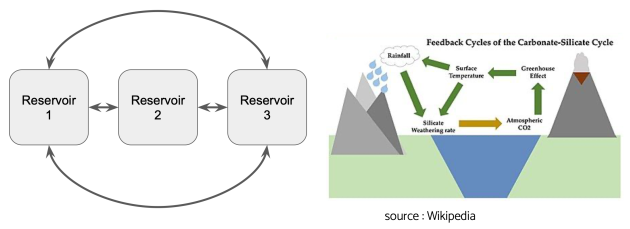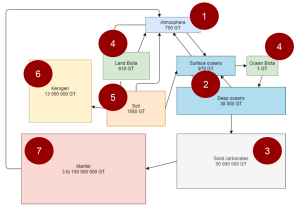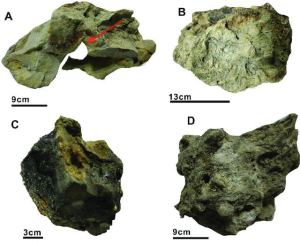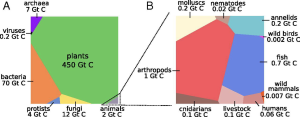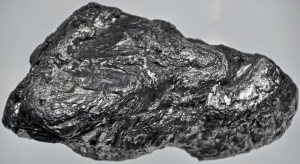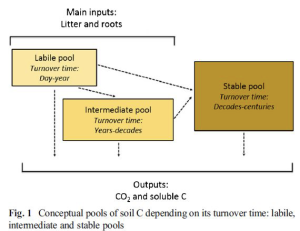Carbon Reservoirs
The concept of reservoir
Carbon reservoirs
Reservoir 2 : Ocean
Reservoir 3: Solid carbonates or carbonates rock
Calcite or calcium carbonate, CaCO3
Xi, Shichuan, Xin Zhang, Zengfeng Du, Lianfu Li, Bing Wang, Zhendong Luan, Chao Lian, et Jun Yan. 2018. « Laser Raman Detection of Authigenic Carbonates from Cold Seeps at the Formosa Ridge and East of the Pear River Mouth Basin in the South China Sea ». Journal of Asian Earth Sciences 168 (décembre) : 207‐24. https://doi.org/10.1016/j.jseaes.2018.01.023
Reservoir 4: Biomass (oceanic and continental)
Graphical representation of the global biomass distribution by taxa.
Bar-On, Yinon M., Rob Phillips, et Ron Milo. 2018. « The Biomass Distribution on Earth ». Proceedings of the National Academy of Sciences 115 (25): 6506‐11. https://doi.org/10.1073/pnas.1711842115.
Reservoir 5 : Soil
Dignac, Marie-France, Delphine Derrien, Pierre Barr , S bastien Barot, Lauric C cillon, Claire Chenu, Tiphaine Chevallier, et al. 2017. Increasing Soil Carbon Storage: Mechanisms, Effects of Agricultural Practices and Proxies. A Review . Agronomy for Sustainable Development 37 (2) : 14. https://doi.org/10.1007/s13593-017-0421-2.
Organic matter turnover (EN) = renouvellement de la matière organique (FR)
shoots (EN) = pousses (FR)
Figure : Soil carbon (C) cycle through the microbial loop. Carbon dioxide (CO2) in the atmosphere is fixed by plants (or autotrophic microorganisms) and added to soil through processes such as ❶ root exudation of low-molecular weight simple carbon compounds, or deposition of leaf and root litter leading to accumulation of complex plant polysaccharides. ❷ Through these processes, carbon is made bioavailable to the microbial metabolic “factory” and subsequently is either ❸ respired to the atmosphere or ❹ enters the stable carbon pool as microbial necromass. The exact balance of carbon efflux versus persistence is a function of several factors, including aboveground plant community composition and root exudate profiles, environmental variables, and collective microbial phenotypes [i.e., the metaphenome (19)].
Naylor, Dan, Natalie Sadler, Arunima Bhattacharjee, Emily B. Graham, Christopher R. Anderton, Ryan McClure, Mary Lipton, Kirsten S. Hofmockel, et Janet K. Jansson. 2020. « Soil Microbiomes Under Climate Change and Implications for Carbon Cycling ». Annual Review of Environment and Resources 45 (1): 29‐59. https://doi.org/10.1146/annurev-environ-012320-082720.
Reservoir 6 : Kerogen
Figure. Photomicrograph of kerogen. This is the sapropelic Kimmeridge Coal (Upper Jurassic) from Dorset, UK. Cross-sections of bivalves are ubiquitous, and carbonized plant detritus is also visible. Reproduced with permission from Selley RC (2000) Applied Sedimentology, 2nd edn. London: Academic Press.

Structure of a vanadium porphyrin compound (left) extracted from petroleum by Alfred E. Treibs, father of organic geochemistry. The close structural similarity of this molecule and chlorophyll a (right) helped establish that petroleum was derived from plants
Kvenvolden, Keith A. 2006. « Organic Geochemistry – A Retrospective of Its First 70 Years ». Organic Geochemistry 37 (1): 1‑11. https://doi.org/10.1016/j.orggeochem.2005.09.001.
